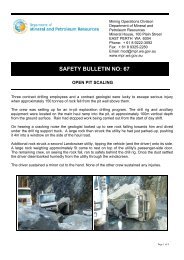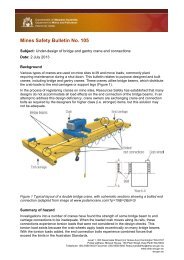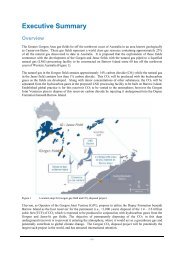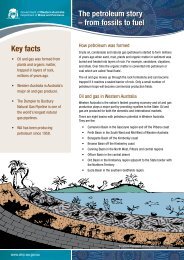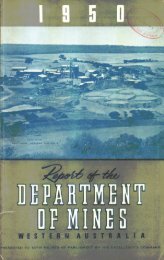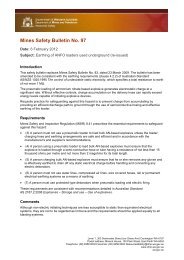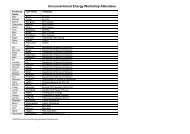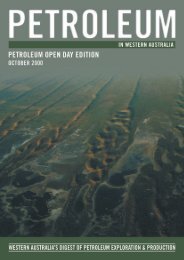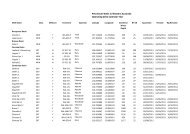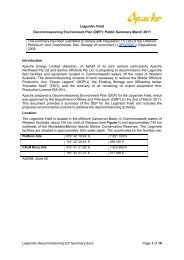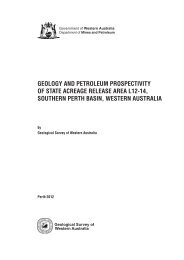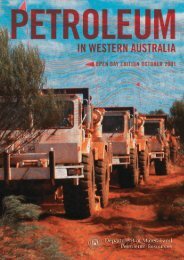Geothermal Energy Potential in Selected Areas of Western Australia ...
Geothermal Energy Potential in Selected Areas of Western Australia ...
Geothermal Energy Potential in Selected Areas of Western Australia ...
Create successful ePaper yourself
Turn your PDF publications into a flip-book with our unique Google optimized e-Paper software.
17<br />
T=T0+QR, where R=z/ (average thermal conductivity between the surface and z).<br />
Consequently the most highly prospective regions for geothermal exploration are<br />
those that have geological units <strong>of</strong> sufficiently low conductivity (high thermal<br />
resistance) <strong>in</strong> the cover sequence comb<strong>in</strong>ed with high heat flow.<br />
Heat flow is the product <strong>of</strong> temperature gradient and rock thermal conductivity. It is<br />
therefore calculated, or modelled, from these two parameters, not directly measured.<br />
The modell<strong>in</strong>g <strong>of</strong> heat flow is a precision skill that requires a detailed understand<strong>in</strong>g<br />
<strong>of</strong> physical conditions <strong>in</strong> the borehole and the physical properties <strong>of</strong> the rocks;<br />
<strong>in</strong>clud<strong>in</strong>g advective processes that may <strong>in</strong>fluence bore temperature (such as ground<br />
water flow or borehole convection), and the temperature dependence <strong>of</strong> conductivity.<br />
Heat flows determ<strong>in</strong>ations are only as accurate as the data used to generate them. It<br />
is therefore important<br />
that temperature and conductivity data used to calculate heat<br />
flow represent as closely as possible the actual thermal conditions.<br />
HDRPL’s 1D Conductive Heat Flow Modell<strong>in</strong>g s<strong>of</strong>tware accounts for the temperature<br />
dependence <strong>of</strong> conductivity. However,<br />
the results <strong>of</strong> 1D heat flow modell<strong>in</strong>g should<br />
be treated with caution when extrapolat<strong>in</strong>g data laterally over considerable distance.<br />
HDRPL recommends a subsequent, more detailed appraisal <strong>of</strong> the Perth Bas<strong>in</strong>,<br />
<strong>in</strong>corporat<strong>in</strong>g the data derived from this study and utilis<strong>in</strong>g 3D conductive heat flow<br />
modell<strong>in</strong>g s<strong>of</strong>tware.<br />
4.3. Verification <strong>of</strong> Well Temperatures<br />
Reported well temperatures measured dur<strong>in</strong>g the drill<strong>in</strong>g process are <strong>of</strong>ten <strong>of</strong><br />
unknown<br />
quality. Even reliably reported temperature data typically underestimate the<br />
true rock temperature because <strong>of</strong> the cool<strong>in</strong>g effect <strong>of</strong> circulat<strong>in</strong>g drill<strong>in</strong>g mud. In<br />
order to ensure the most accurate data are used <strong>in</strong> the thermal modell<strong>in</strong>g process,<br />
statistical corrections (such as Horner Plots) can be applied to time series data<br />
recorded dur<strong>in</strong>g the logg<strong>in</strong>g process.<br />
The Horner plot method corrects for bore hole cool<strong>in</strong>g created by the drill<strong>in</strong>g process<br />
us<strong>in</strong>g the parameters <strong>of</strong> recorded bore hole temperature; the time s<strong>in</strong>ce the last fluid<br />
circulation; and the time elapsed between<br />
the end <strong>of</strong> drill<strong>in</strong>g and the cessation <strong>of</strong> fluid<br />
www.hotdryrocks.com



